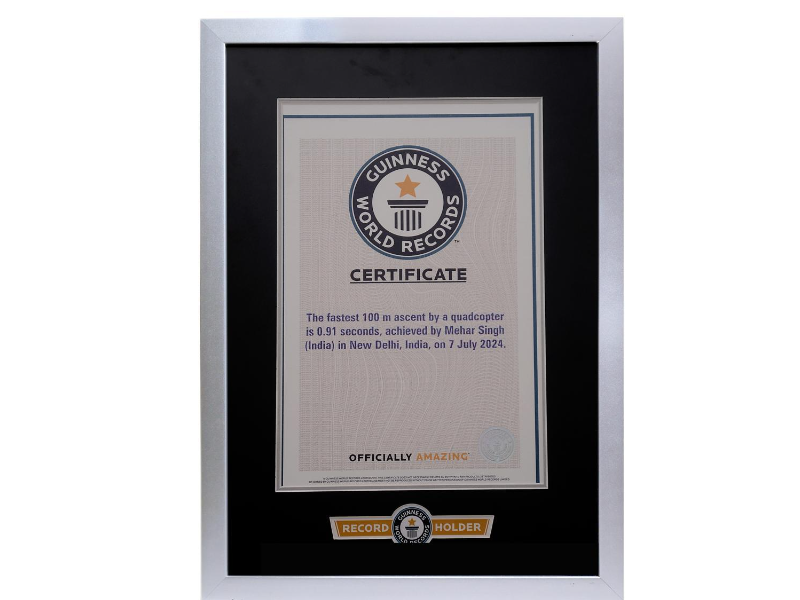Mehar Singh, a 17-year-old innovator, has achieved global recognition by setting a new Guinness World Record for the fastest 100-meter ascent by a quadcopter. Singh's custom-built drone accomplished this feat in a mere 0.91 seconds, demonstrating his exceptional technical skills and establishing a new benchmark in drone technology.

Singh's passion for drones began in the 8th grade and has since evolved into an ambition to explore the limits of what drones can achieve. His record-breaking project involved months of designing and building a drone capable of unparalleled vertical acceleration.
"I've always been fascinated by the idea of pushing the limits of what drones can do," Singh stated. "Breaking a world record wasn’t just about the end result; it was about the process. I wanted to prove that current technology could achieve something extraordinary, but the path to get there was filled with challenges."
The project demanded that Singh design, test, and refine numerous drone prototypes. He faced significant challenges throughout the process. “There were moments when I felt like I was chasing an impossible dream,” Singh recalled. “I went through countless designs, and many of them failed during testing. Some drones crashed so badly that I had no choice but to go back to the drawing board and start from scratch. Each crash was a setback, but it also sparked new ideas and innovations.”
Singh remained committed to his goal, focusing his efforts on creating a drone that was both fast and aerodynamically optimized. “I spent countless hours on CAD software, meticulously designing and tweaking each component. The goal was to make the drone as streamlined as possible, which led me to shape it like a rocket. This design wasn’t just about aesthetics; it was about reducing drag and maximizing speed.”

Singh credits his success to the lessons learned from each setback. “Every failure taught me something valuable,” he said. “It forced me to think creatively and to consider every detail, from the materials used to the weight distribution of the drone. The process was grueling, but it was also incredibly rewarding to see my ideas take flight—literally.”
This achievement has significant implications for the future of drone technology. “The possibilities are endless,” Singh mused. “High-speed vertical acceleration could revolutionize everything from emergency response to space exploration. This isn’t just about setting a record; it’s about opening doors to new innovations and applications.”
Singh's work is inspiring others in the drone community. “I hope this accomplishment encourages other young innovators to push their own boundaries,” he said. “Technology is advancing rapidly, and there’s so much potential waiting to be unlocked. I’m excited to see where we can go from here.”

With his record-breaking drone, Mehar Singh has not only achieved a personal triumph but has also paved the way for future advancements in the field. His journey marks just the beginning of a promising career in technological innovation.
Newer articles
Older articles
 Esha Gupta Sets Record Straight: Actress Addresses Hardik Pandya Dating Rumors
Esha Gupta Sets Record Straight: Actress Addresses Hardik Pandya Dating Rumors
 Google Maps to Boost Navigation Accuracy with Fused Orientation Provider API
Google Maps to Boost Navigation Accuracy with Fused Orientation Provider API
 Global Vaccination Rates Plunge: Millions of Children Now Vulnerable to Preventable Diseases
Global Vaccination Rates Plunge: Millions of Children Now Vulnerable to Preventable Diseases
 Rishabh Pant: Greg Chappell Hails India Star as Cricket Revolutionary
Rishabh Pant: Greg Chappell Hails India Star as Cricket Revolutionary
 Skin Cancer Alert: How to Identify Suspicious Moles and Early Warning Signs
Skin Cancer Alert: How to Identify Suspicious Moles and Early Warning Signs
 Gavaskar Calls for Kuldeep Yadav's Inclusion in Second Test Amid Bumrah Fitness Concerns
Gavaskar Calls for Kuldeep Yadav's Inclusion in Second Test Amid Bumrah Fitness Concerns
 Is Daily Pooping a Must? Understanding Bowel Regularity and When to Worry
Is Daily Pooping a Must? Understanding Bowel Regularity and When to Worry
 Suryakumar Yadav's Sports Hernia: Understanding the Injury, Recovery, and Risk Factors for Athletes
Suryakumar Yadav's Sports Hernia: Understanding the Injury, Recovery, and Risk Factors for Athletes
 Vijay Sethupathi Apologizes Amid Controversy Over Son Surya's Debut Film 'Phoenix' and Alleged Video Removal Pressure
Vijay Sethupathi Apologizes Amid Controversy Over Son Surya's Debut Film 'Phoenix' and Alleged Video Removal Pressure
 Install Baccarat Hack Tool: The Secret to Winning
Install Baccarat Hack Tool: The Secret to Winning